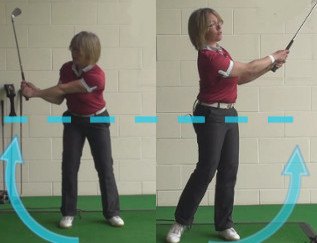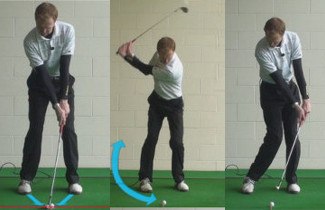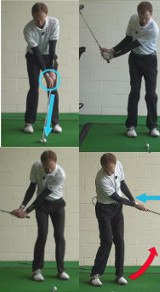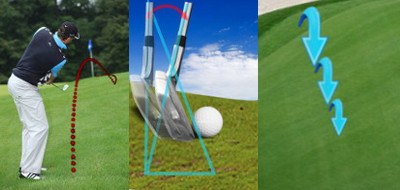Pitching the golf ball is a skill that is often 'lost in the shuffle'. Even players who are careful to work on all aspects of their game during practice can easily overlook pitching, as it lands in an in-between category that isn't really the long game but isn't the short game, either. If you take time to work on both your full swing and your short game during the average practice session, you still might come away having failed to work at all on your pitching technique.

Of course, this is a problem, as pitching is an important skill to have in your bag of tricks. Most golfers would consider a pitch shot to be one that is played from somewhere between 15 – 30 yards away from the target. Which, for the average amateur golfer, is a distance that happens to come up quite frequently during a typical round. If you are unprepared to play quality shots from this distance range, you will find that you are adding strokes to your score on a regular basis.
Pitch shots are often lost in the area between the long game and the short game. They require less than a full swing, but more than a chipping action – and as a result, many players simply forget to practice this important type of shot. You’ll likely find yourself facing at least a few pitch shots during each and every round, so it’s important that you know how to handle them properly.
In this article, we will cover the topic of pitch shots from a variety of angles. We will talk about what pitch shots are and the various ways you can approach them, depending on the situation that you face. We’ll also cover the basics of good technique, common mistakes, and some key strategy points to keep in mind. Pitching the ball is a skill that intimidates many average players, but it doesn’t have to be that way in your game. If you are willing to put in some practice time, you just might be surprised to find how many shots you can save with improved pitching skills.
All of the content below is based on a right-handed golfer. If you happen to play golf left-handed, please take a moment to reverse the directions as necessary.
— What is a Pitch Shot?
There is no exact definition of a pitch shot. The line can be blurry between what is a chip and what is a pitch, and to be honest, it doesn’t matter much how you define them. Pitch shots are longer than chip shots, but the distance at which a chip turns into a pitch is really up to you and your technique.
It might be helpful to think of a pitch shot as a miniature version of your full golf swing. The mechanics of your pitching motion will look generally similar to the shape of your full swing, only much smaller. On the other hand, your chipping technique is closer in relation to your putting stroke than it is to your full swing. So, if you are getting ready to hit a shot and you are going to use what is basically a little version of your full swing, it’s safe to say you are hitting a pitch.
If you would like to attach some distances to pitch shots as a point of reference, the 20-yard to 40-yard range is a good place to start. Again, this is by no means an exact definition. But shots in that distance range will often look and feel like pitches. Of course, this is a distance that happens to scare many players, as shots from this range are notoriously tricky to pull off successfully. If thinking about hitting a 30-yard shot up onto the green makes you nervous, it’s about time you got down to work on your chipping technique.
There are plenty of situations that can come up during a round of golf where you will be left with a pitch shot. To make sure you understand the importance of improving your pitching, let’s take a moment to highlight a few of the many ways you can find your ball resting this awkward distance from the target.

- Good drive on a short par four. This is a great situation to be in for a pitch shot. If you are playing a relatively short par four and you’ve hit a powerful drive from the tee, you might find yourself far enough up the fairway to be left with a pitch for your second. From this position, you should be thinking about hitting a good pitch and knocking the putt in for a birdie. At the same time, you don’t want to take on too much risk with the pitch and put the ball in trouble – that kind of mistake could bring bogey into the equation. Do your best to play a pitch that leaves the ball under the hole, presenting you with an uphill birdie putt and an easy par if the birdie putt happens to miss.
- Strong second shot on a par five. This is a very similar situation to the first one. If you have hit a nice drive and a good second shot on a par five hole, you might wind up with a pitch for your third. Again, an up and down here would leave you with a birdie, so this is a good opportunity to move your round in the right direction.
- Scrambling after a poor drive. Unfortunately, many pitch shots are played in situations that are not as desirable as the first two points on our list. Often, you will need to pitch the ball onto the green after hitting a poor drive on a par four and being unable to reach the putting surface with your second shot. It’s particularly helpful to have strong pitching skills in this situation as you might be able to escape with a par despite your poor drive. Also, when you have confidence in your pitching, you will feel comfortable playing a conservative shot with your second out of the trees, rough, sand, etc. Players who know they struggle to hit good pitch shots are prone to get too aggressive with those approaches from bad spots, thinking they have to get all the way to the green if they are going to save a par. Build up your pitching prowess and you can actually take some of the pressure off of other parts of your game.
- Came up short on a long par three. It’s not uncommon, depending on what tees you play, to find par three holes that stretch to 200-yards and beyond. When you face a long par three, you might come up well short of the green from time to time. This is another occasion where you will need to hit a good pitch shot to set yourself up with a makeable par putt. Long par threes always represent a tough challenge, so getting up and down for a par after leaving your tee shot short is a satisfying feeling.
You never quite know when you’ll find yourself needing to hit a quality pitch shot. Some pitch shots are relatively easy, with nothing much of note between your ball and the hole. On the other hand, it’s possible to find extremely difficult pitch shots, where you need to carry the ball over water or sand before landing it on the green and stopping it by the cup. If you can build good fundamentals for your pitching technique, and then build confidence in that technique through consistent practice, it’s possible to handle these shots nicely time after time.
— The Fundamentals of Pitching the Golf Ball
It’s always helpful in golf to have fundamentals on your side. When you have good fundamentals in place, you can repeat positive results over and over again. Without that base on fundamentals working to your advantage, it will be hard to consistently get the kinds of outcomes you want on your pitch shots. Sure, you might hit a good one from time to time even with bad technique, but those successes will be few and far between. Take the time to build some solid fundamentals in this area of your game and your confidence is sure to grow.
| GOLF FIXES BY PGA PROS |
|---|
| Evaluating The Lie For Better Golf Pitch Shots | Video | Article |
| Proceed With Caution For Golf Pitch Shots | Video | Article |
| Good Lie Pitch And Check Shot | Video | Article |
| Fix Short Pitch Problem Hinge Wrists Early | Video | Article |
| Golf Bounce, Used for Crisp Pitch Shots | Video | Article |
| Hold Clubface Open to Make Pitch Shots Check | Video | Article |
| Hold The Golf Club Face Open To Make Pitch Shots Check | Video | Article |
| The Correct Wrist Bend For A Close In Golf Pitch Shot | Video | Article |
| Correct your Golf Pitch Shots with a Basic Wrist Hinge | Video | Article |
| Cure Short Pitch Golf Shots – Break Wrists Early | Video | Article |
| Use Sand Wedge to Pitch from Thick Rough | Video | Article |
| Cure and Fix Your Golf Pitch Shots with Proper Wrist Bend | Video | Article |
| How To Avoid Disaster With Golf Pitch Shots | Video | Article |
| Use The Correct Swing For Golf Pitch Shots | Video | Article |
| Changing Wrist Bend For Higher Or Lower Golf Pitch Shots | Video | Article |
| Look Past the Pin on Short-Side Pitch Shots | Video | Article |
| Making The Right Swing To Pitch The Ball Into Firm Golf Greens | Video | Article |
| Making The Right Swing To Pitch The Ball Into Firm Golf Greens | Video | Article |
| Modifying Your Set Up For Golf Pitch Shots | Video | Article |
| Correct wrist bend for close in pitch shot in Golf | Video | Article |
| Pitch, Don’t Chip, When Playing Aerified Greens | Video | Article |
| When to Chip When to Pitch Near Green | Video | Article |
| Pitching Setup Lesson | Video | Article |
| Tucked Pin Pitching Tip | Video | Article |
| Perfect Pitching Conditions To Make The Golf Ball Check | Video | Article |
| The Basic Golf Pitching Technique | Video | Article |
| Beginner Golf Tip – The Correct Mentality When Pitching | Video | Article |
| Beginner Golf Tip – Using The Correct Ball When Pitching | Video | Article |
| LESSONS |
|---|
| Beginner Golf Pitching: What is Pitching? | Video | Article |
| Low Running Pitch Shot Lesson | Video | Article |
| Normal Pitch Shot Lesson | Video | Article |
| How The Club Face Impacts Pitch Shots | Video | Article |
| Spinner Pitch Shot Lesson | Video | Article |
| Pitch Shots With Varying Levels | Video | Article |
| Beginner Golf Tip – Key Elements To A Solid Pitch Strike | Video | Article |
| Heel Off the Ground Pitch Shot | Video | Article |
| Should You Break Your Wrist For Golf Pitch Shots | Video | Article |
| Chip Shots Differences Compared To Pitch Shots | Video | Article |
| Pitch Shot – Style Points vs High Percentage | Video | Article |
| Chip Vs Pitch How And Why, Ladies Golf Tip | Video | Article |
| Pitch With More vs Less Wrist Hinge | Video | Article |
| Break Wrist Early On Short Golf Pitch Shots | Video | Article |
| The Lofted Golf Pitch | Video | Article |
| Break Wrists Early on Short Pitch Shots | Video | Article |
| How the Clubs Bounce Helps with Crisp Pitch Shots | Video | Article |
| Breaking Your Wrists For Adding Backspin To Your Golf Pitch Shots | Video | Article |
| Learning A Spinning Pitch To Encourage A Super Late Release Golf Swing | Video | Article |
| Using The Core To Power Golf Pitch Shots | Video | Article |
| Why the Clubs Bounce Can Help Create Perfect Pitch Shots | Video | Article |
| Characteristics Of Each Golf Shot Chip Versus Pitch | Video | Article |
| Using The Right Equipment For Your Pitch Shots | Video | Article |
| Pitch Shot | Video | Article |
| Chip Versus Pitch Golf Tips | Video | Article |
| How To Pitch With a Shorten Arm Swing | Video | Article |
| Confidence Is Crucial For Better Golf Pitch Shots | Video | Article |
| How To Pitch With a Shorten Arm Swing | Video | Article |
| Confidence Is Crucial For Better Golf Pitch Shots | Video | Article |
| Never Duff Your Pitch Shots Again | Video | Article |
| How To Pitch Like A Golf Pro | Video | Article |
| Creating Spin On Golf Chip And Pitch Shots | Video | Article |
| Pitching With Quiet Wrists For Golf Pitch Shots | Video | Article |
| Beginner Golf Pitching: What is Pitching? | Video | Article |
| Pitching Distance Lesson | Video | Article |
| How To Improve Your Golf Pitching Problems | Video | Article |
| The Right Mindset When Golf Pitching | Video | Article |
| Pitching Setup Lesson | Video | Article |
| Improve Your Golf Pitching Problems | Video | Article |
| Trouble Shooting Golf Pitching Issues | Video | Article |
| Mastering The Basics Of Golf Pitching | Video | Article |
| Pitching Distance Lesson | Video | Article |
| Open Lead Foot For Better Golf Pitching | Video | Article |
| Flop Shot Pitching Lesson | Video | Article |
| When Pitching Keep Your Rear Shoulder Moving Lesson | Video | Article |
| Pitching Wedge A Handy Tool For Many Shots | Video | Article |
| Pitching From Tight Lies Lesson | Video | Article |
| Pitching – Advanced Soft Toe Flop Shots | Video | Article |
| Pitching With Quiet Wrists For Golf Pitch Shots | Video | Article |
| Additional Golf Pitching Tips | Video | Article |
| Short Chip Shots With A Pitching Wedge | Video | Article |
| Building A Solid Golf Pitching Action | Video | Article |
| The Basic Full Pitching Wedge Golf Swing | Video | Article |
| Control Pitching Distance with Underhand Toss Tip | Video | Article |
| Beginner Golf Tip – Honing Your Pitching Technique | Video | Article |
| The Basic Of The Golf Pitching Technique | Video | Article |
| Focusing More On The Hands And Arms When Golf Pitching | Video | Article |
| The issue of nerves when chipping and pitching in golf | Video | Article |
| The Occasional Golf Bunker Shot With A Pitching Wedge | Video | Article |
| Hitting The Ball Fat Or Thin Troubleshooting When Golf Pitching | Video | Article |
| The Pitching Wedge A Handy Tool For Many Golf Shots | Video | Article |
| The Best way for Women to Control Pitching Distance when Playing Golf Shots | Video | Article |
| How Senior Golfers can Best Control Pitching Distance to Improve their Accuracy | Video | Article |
| The Pitching Wedge Living Up To Its Name In Golf | Video | Article |
| PRACTICE DRILLS |
|---|
| Right Hand Golf Tip: Try to Keep Club Face Open to Help Pitch Shots to Check | Video | Article |
| Shorter Golf Swing Drill 6 Pitch your driver | Video | Article |
| The 1 Yard Pitch Shot Golf Game | Video | Article |
| Crisp Pitching no Scoops with Left Handed Drill | Video | Article |
| GOLF QUESTIONS |
|---|
| How Can I Get My Golf Pitch Shots To Check On The Green More? | Video | Article |
| How Can I Hit A Golf Pitch From Thick Rough? | Video | Article |
| How Can I Pitch From Tight Lies Around The Green? | Video | Article |
| What Should My Wrists Do To Hit Perfect Golf Pitch Shots? | Video | Article |
| What Should My Wrists Do To Hit Perfect Golf Pitch Shots? | Video | Article |
| When Should I Break My Wrists On A 50 Yard Golf Pitch Shot? | Video | Article |
| When Should I Open The Face Of My Golf Pitch Shots | Video | Article |
| Pitching Wedge Tips, Should I Just Use It For All Golf Shots Around The Green | Video | Article |
| Golf Pitching, (Video) Tips – by Dean Butler | Video | Article |
| How Can I Quickly Become Better Pitching Golf Shots? | Video | Article |
To get started building the kind of technique that can last in your pitching game, review the points below.

- Use all of the club. This is a great place to start because it is a place where so many golfers go wrong. Since pitch shots are played from relatively close to the green, many players think they need to choke way down on the club before hitting the shot. That’s simply not the case. While it’s okay to choke down a little bit if doing so makes you more comfortable, try building your technique while using the whole club. Keeping your hands up at the top of the grip will allow the club to feel heavier, and you should have better tempo in your pitch shots as a result. When you choke down, you lose some of your feel for the club head and you might wind up with a quick tempo that gets you into trouble. As you work on your pitching technique, start by using the whole club and only make the decision to choke down if you aren’t having success keeping your hands up at the top.
- Wide enough stance to stay stable. When chipping the golf ball, you probably keep your feet pretty close together to build a comfortable stance. And, for a chip shot, that’s a good idea. However, when you move back and are hitting a pitch shot, you need a slightly wider stance to make sure you can stay balanced properly while turning back and through the shot. Remember, this is like a small version of your full swing, so it’s possible to lose your balance if your stance is too narrow. There will be some experimentation required to find the right stance width for your needs but start at roughly shoulder width and adjust from there as necessary.
- Head perfectly still. You need to make clean contact if you are going to hit good chip shots. And, to make clean contact, you need to keep your head still. That might sound like a pretty easy thing to do, but it’s easy to fall into the trap of looking up early to see where the ball is going to go. During practice, pay close attention to your head as the club swings and make sure you are keeping it as still as possible. It will be even harder to keep it still on the course than it is in practice, so teach yourself to be disciplined in practice so you can have success when under pressure on the links.
- Hands over the ball at impact. This is one of the big areas where players run into trouble. If you have your hands too far forward at impact, you’ll hit a low shot that may not stop quickly enough. On the other end of the spectrum, keeping your hands too far back when trying to strike the ball can lead to fat and thin shots. So, the solution for most pitch shots is to play them with your hands over the ball at impact, or just slightly in front. This way, you will expose most of the loft of the club to the ball at the bottom of the swing, making it easy to get the shot up into the air with plenty of spin. Of course, if you want to hit a lower pitch on purpose based on the circumstances you are facing, you can always move your hands forward at address to make that possible.
- Keep the club moving. As you approach impact, you might feel an urge to slow the club down slightly. This might be from a fear that you are going to hit the shot too far, or it may be that you aren’t confident in a clean strike. Whatever the case, it’s important that you manage to keep your nerve up and swing on through impact. By the time you are swinging down toward the ball, it’s too late to make any real changes or ‘save’ the shot – so you might as well trust it and have enough confidence to expect a good outcome. Not every shot will work out as you hoped, of course, but swinging through with confidence will lead to far better results than doubting yourself and slowing the club down through the ball as a result.
While you practice your pitch shots, keep these points in mind and make any adjustments that you feel are necessary to your technique. One point we didn’t include above is ball position. For a standard pitch, you will probably want to play the ball near the middle of your stance. However, adjusting your ball position is a great way to produce different kinds of pitch shots, so don’t be afraid to experiment in practice and add to your repertoire.
— Avoid These Common Mistakes
There are plenty of ways to go wrong with a pitch shot, unfortunately. Among the many possible negative outcomes, a few common issues seem to pop up over and over again for the average player. If you have been having trouble lately with your pitches and you need to correct one specific mistake, there is a good chance that error is listed below.

- Getting steep. Countless players hit down too hard on their wedge shots. If you are swinging steeply down into the ball, and taking a huge divot after you make contact, it’s going to be hard to find good results. Yes, you do want to hit down on most of your pitch shots, but not so much that you are taking a big chunk of the turf with you when the club goes through. It’s hard to judge how the ball is going to come out when you swing so steep, and you’ll always be just a small mistake away from hitting the shot fat. Try to shallow out your angle of attack by using less hands and wrists during the takeaway phase of the swing. By keeping your hands quiet early in the swing, your arc will shallow out and you should be able to hit through impact with a slight downward angle.
- Leaving the shot short. It’s common to see pitch shots come up short when playing with average golfers. Often, it’s a fear of hitting the ball too far that causes the player to come up so far short of the target. After all, you are capable of hitting the club you are holding much farther than the distance at hand, so you might be fearful of getting too much of the ball and sending it over the green. To compensate, you make a very gentle swing and wind up falling short of the target. One good way to get over this issue is to pick out a specific landing spot for your pitches. If you can select a spot on the green where you think the ball needs to land, you can then focus your attention on that spot and do your best to execute the shot.
- Ignoring the lie of the ball. Some kinds of shots are just not possible from some kinds of lies. If you are trying to play your pitch shots the same way each and every time, regardless of how the ball is resting, you are doing something wrong. For instance, you might like to play your pitch shots with quite a bit of spin, stopping them quickly after a couple of bounces. That’s great, but it won’t work well out of the rough. If you have a lie where the ball is surrounded by longer grass, you’ll have to adjust your plan and play for more bounce and roll. It’s always important to assess the lie of the golf ball before playing any shot, and that is certainly true when a pitch is required.
It’s no fun making the same mistakes over and over again on the golf course. Whatever mistake it is that you happen to make repeatedly on your pitch shots, address it as soon as possible and look for a viable solution.
— Pitch Shot Strategies
There is a strategic element to each and every shot you play during a round of golf. If you aren’t thinking in a strategic manner while playing each round, you are missing out on an opportunity to lower your scores – it’s just that simple. With regard to pitch shots, there are a few basic strategic keys to keep in mind, including those listed below.

- Always below the hole. There are two main goals that you should have in mind for every pitch shot. For starters, you want to get the ball on the green to set up a putt for your next shot – that one probably goes without saying. From there, your next goal should be to set up an uphill putt as often as possible. When you leave the ball below the hole, you are giving yourself an opportunity to be aggressive with your putt. It’s a big advantage to putt uphill, yet this point is overlooked by countless players. As you assess your pitch shot options, evaluate the slope of the green and figure out where you need to be to putt uphill.
- Start down and then look up. When given the option, you should always favor a low pitch shot rather than a high one. This is a good strategy because it is easier to control low pitch shots, and there is less that can go wrong. You can pull off some pretty impressive shots by playing your pitches higher, but you are taking on extra risk in the process. So, as a general rule of thumb, evaluate your options by looking low first and only opt for a higher route when the low path just isn’t going to work.
- Land on a flat spot. If you have the option, try to land your ball on a flat section of the green. This won’t always be possible, of course, but it makes it easier to predict the bounce and roll you’ll get on your shots when the ball lands on a relatively flat patch of ground. Take a look at the area between your ball and the hole and figure out what section of ground would make for the best landing spot. Then, with that landing spot identified, pick out the club that will let you pitch the ball to that spot before it bounces and rolls up to the hole.
We hope you now realize that hitting good pitch shots is well within reach. Sure, it’s going to be a tough skill to learn, and you will probably hit quite a few bad shots along the way, but don’t give up. Once you become confident in your ability to hit a good pitch, you’ll find that the game will open up and you’ll have more confidence in other areas, as well. Thanks for reading and good luck!






